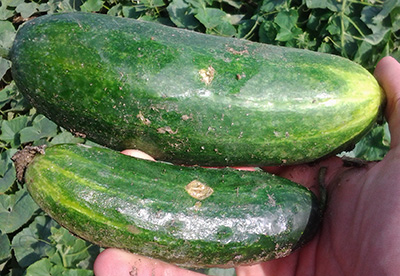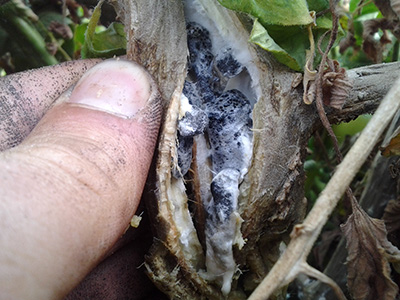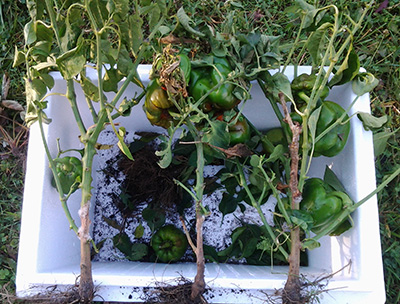East Michigan vegetable regional report – August 12, 2015
The season is shaping up. This is the month everyone lives for.

Weather
A warm front is coming through this week, with some rain expected Friday, Aug. 14.
I was able to meet new growers this week. I always like that.
Here are the rainfall and growing degree day (GDD) base 50 degrees Fahrenheit accumulations to date from Michigan State University Enviro-weather stations.
Rainfall and GDD summary | ||
|---|---|---|
|
Location |
GDD (50F, March 1) |
Rainfall (inches, April 1) |
|
1,781.6 (164.6 behind average) |
11.45 (0.52 since last week) |
|
|
1,913.2 (193.2 behind average) |
11.71 (0.50 since last week) |
|
|
1,889.3 (193.2 behind average) |
15.11 (0.60 since last week) |
|
|
1,906.1 (113.1 behind average) |
13.79 (0.38 since last week) |
|
Crops
Sweet coreless carrots are being harvested, averaging about 6 inches in length. Water logging in low spots of some fields have caused unmarketable forked carrots.
Sweet corn harvest continues. Japanese beetles have been found eating silks down to the wrapper leaves, and rust is showing up in some varieties. European Starlings, Red-winged Blackbirds, and raccoons become a problem this time of year. Growers interested in lethal control of these animals should reference Erin Lizotte’s and James DeDecker’s article, titled “Do I need a permit to control wildlife on my farm?”
I have been harvesting seedless pickling cucumbers, planted at the beginning of July. Of the 12 varieties tested, three are ready now, with others still grading in the 2A-2B range. We expect to harvest the remaining nine by Saturday with two 80-degree days ahead of us, and a call for a little more rain. The softest skinned varieties are showing healing scars from hail damage.

Hail damage on pickling cucumbers from the storm Aug. 2-3.
Melons and watermelons are hitting markets.
Winter squash and pumpkins are setting fruit. Stay on top of powdery mildew to keep shade on the fruit. This is especially important on lighter colored fruit. Xanthomonas bacterial leaf spot is occurring more frequently in Michigan. I sent some samples to the lab recently that came back positive for this disease.
Field tomatoes and peppers are being harvested. White mold will show up in greenhouse tomatoes with high humidity. There are not many effective chemical treatments labeled for greenhouse use, so ventilation and pruning is important for that system. Regular rogueing can help delay infestation.
I helped remove two infested plants from two greenhouses last week. Do so with caution as the disease tends to make plant stems brittle. When they shatter open you will see the white mold has left dozens of black, pebble-like structures inside to be flung to the ground. These can reside in the soil or rock floor of your greenhouse for many years and sprout tiny mushrooms in the spring that spread spores that land on their many host plants. The spores typically initiate infections through flowers and can infect plant stems when flowers fall off and get lodged in the crooks of branches.

White mold sclerotia inside the dried out stems of infected greenhouse tomatoes. Remove brittle plants cautiously to avoid spreading these pebble-like, overwintering life-stage of the disease.

White mold fuzz infected field pepper stems. Hot and humid conditions spread this to many flowering vegetables. Infected flowers get stuck in the nooks of branches and infect the stems. The stems stop moving water and nutrients to the fruits and the plant collapses.
We have not found any late blight in tomatoes yet this year, but growers should be judiciously applying protectant fungicides for late blight. Please see “Potato late blight update and late-season recommendations for 2015” or Michigan State University Extension Bulletin 312, “2015 Insect, Disease and Nematode Control for Commercial Vegetables,” for a listing of fungicides that are registered.
Highlander storage onions are being harvested this week. Candy onions on plastic beds with driving lanes on the western edge are showing some sunscald on their shoulders. Red onions appear to be more afflicted by this. I’m not sure if the plastic has anything to do with it, but the drive lanes of 5 feet or more limit the shading that neighboring onions would do in a tighter spaced system.

Red sweet onions with sunscald.
Please contact me at phill406@msu.edu or 989-758-2502 to pick up any suspected disease samples, or send the diseased plant parts to MSU Diagnostic Services.



 Print
Print Email
Email


